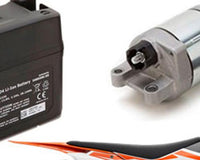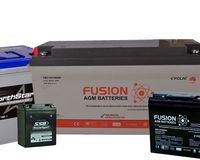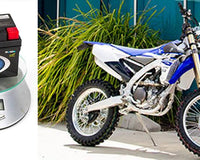Table of Contents
The battery is the heart of your motorcycle. It determines your bike’s performance as well as your ability to enjoy a smooth yet thrilling ride.
You need to understand the different motorcycle battery options available on the market to simplify your decision-making process.
All motorcycle batteries are similar in multiple ways, including their voltage, which stands at 12V. Another similarity is the use of lead electrodes dipped in an electrolyte—a mixture of distilled water and sulphuric acid or lead sulphate solution—to create an electrical charge.
Batteries suitable for motorbikes also differ in multiple ways, making some superior to others.
- The three common types of motorbike batteries are:
- Wet cell or conventional batteries
- Dry cell or absorbed glass mat (AGM) batteries
- Gel cell or maintenance-free batteries
An Overview Of Motorcycle Battery Types
Three types of batteries that you should compare for your motorcycles.
Wet Cell or Lead Acid Batteries
Wet cells are also known as conventional batteries because they’re the most common type of motorbike battery. Another term for them is 'flooded batteries' because of their high liquid content (65% water compared to 35% sulphuric acid) that moves freely in an unsealed container.
Wet cell batteries have lead plates, which react with the electrolyte to produce an electric charge. As a result, they are prone to water loss. Hence, it’s essential to check the water levels and refill the battery with distilled water to elongate the battery’s lifespan and avoid damaging the battery plates.
An advantage of wet cell batteries is that they are rechargeable; however, they give off toxic and highly explosive hydrogen gas when charging and discharging.
You can easily distinguish wet cell batteries from other motorcycle batteries, thanks to the rows of stoppers at the top. For instance, 6-volt wet cell batteries have three stoppers, while 12-volt batteries have six stoppers. They also have reference numbers with letters, such as YB14L-A2.
| PROS | CONS |
| Affordable | Vulnerable to spillage |
| Large number of charge-discharge cycles | Discharge faster than other battery types |
| Less likely to suffer damage from overcharging |
Dry Cell or AGM Motorcycle Batteries
Dry cell batteries use the same electrolyte as wet cell batteries.
The difference, however, is that AGM batteries use a superior performance electrolyte technology. The electrolyte is held in fibreglass mats that are sponge-like and soak up the electrolyte, so it doesn't slosh around the cell.
The technology ensures the battery is sealed when it starts running on your motorbike, meaning it becomes spill-proof.
The fibreglass mats give them some vibration and heat resistance capabilities, making them suitable for a diverse range of uses, such as in motorcycles, lawnmowers, utility vehicles, scooters, quad bikes, and watercraft.

Dry cell batteries deliver your motorcycle's power requirements (12.7 volts at full charge, dropping to 11.6 V at 80% depletion) while requiring minimal maintenance. They are increasingly efficient, which is pushing them to become conventional motorcycle batteries.
| PROS | CONS |
| Maintenance free | Sensitive to overcharging |
| It can be put to a variety of uses | Cheaper than gel cell batteries |
| Improved performance thanks to the absorbed glass mat construction |
Gel Cell Powersports Batteries
A thick silica gel holds the electrolyte in gel cell batteries, reducing the electrolyte movement and eliminating chances of spillage or leakage.
Additionally, the battery is hermetically sealed when manufactured; so you don’t need to refill it at any time during its lifespan. The silica gel also delivers other advantages, such as ensuring you can install the battery at all angles, and it produces little-to-no fumes.
The gel cell motorcycle battery operates under pressure, but it can’t be charged using a quick charger. Instead, it requires you to use a trickle charger.
The battery’s lack of corrosion, spillage and evaporation issues common in other motorcycle batteries boosts its superior performance. Even better, it’s resistant to shock, vibration, and extreme temperatures.
| PROS | CONS |
| Don’t discharge when placed in a proper store location | Heavy due to the gel |
| Zero leaks | Slow to recharge on trickle charge |
| Maintenance free | Prone to overheating |
Which Motorcycle Battery Should I Buy?
Each of the above-mentioned battery types has its advantages and disadvantages. The one you buy depends on the features you prefer and need the most. We recommend referring to your owner’s manual and go for the battery whose rating is closest to the one specified by the vehicle manufacturer. In summary:
| WET CELL | DRY CELL | GEL CELL | |
| Absorption voltage range | 14.4 to 14.9 volts | 14.4 to 15.0 volts | 14.0 to 14.2 volts |
| Float voltage range | 13.1 to 13.4 volts | 13.2 to 13.8 volts | 13.1 to 13.3 volts |
| Weight | Heavier | Heavy | Heaviest |
| Charging times | Slower (up to 12 hours) | Slow (4-5 hours) | Slowest (5 times longer than charging an AGM battery) |
| Emission | Emits a lot of hazardous hydrogen gas | Reduced hazardous gas emission | It does not emit any hazardous gases |
| Operating temperature range | -15℃ to 54℃ | Below 0℃ and above 80℃ | -20℃ to 45℃ |
| Cost | Most affordable | Slightly expensive | Most expensive |
According to us here at Battery Specialists, the AGM battery is the best for motorbikes. Why? It’s light, very portable, long-lasting, and resistant to vibrations. Of course, we can’t ignore the fact that you can get it at a fair price, and it’s faster and easier to recharge without the need for special charging equipment.
With AGM batteries, you can enjoy using your motorcycle on rough terrain or in extremely cold or remote locations without worrying about spillage or needing regular maintenance.
Buy Your AGM Motorcycle Battery From Us
AGM batteries guarantee better performance than their wet and gel cell battery counterparts. They also promise a smoother ride by having the most impact resistance and least internal resistance.









